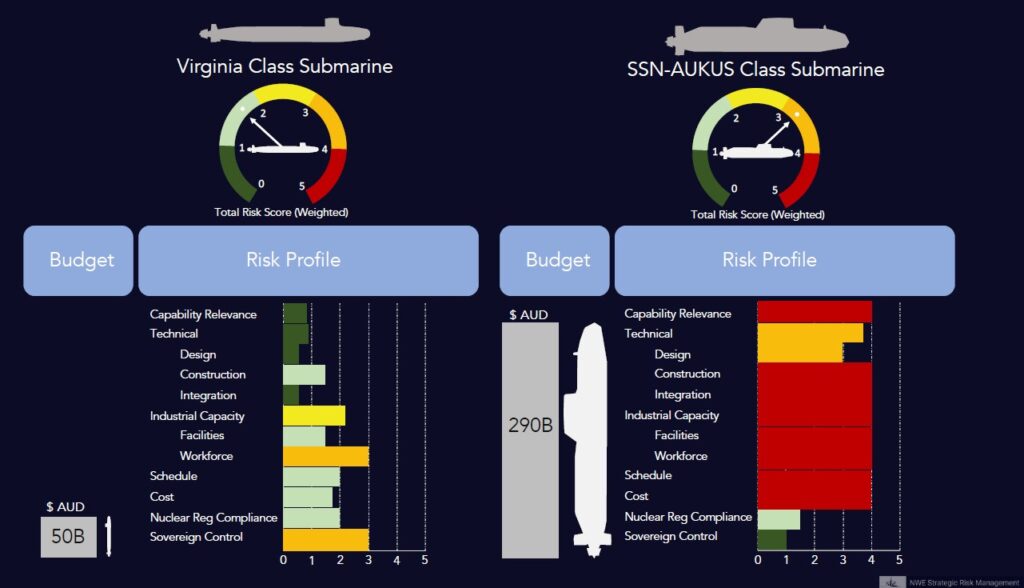
Australia should reconsider its participation in the SSN-AUKUS program in favor of expanding its fleet of Virginia Class submarines, according to a recent risk report. The report, titled “AUKUS Pillar 1 – Submarine Platform Risk Comparison,” was published by NWE Strategic Risk Management and authored by Peter Robinson, a principal at the firm.
The report provides a comprehensive risk analysis comparing the acquisition of Virginia Class submarines from the United States with the SSN-AUKUS nuclear-powered submarines under the AUKUS trilateral agreement. Key factors considered in the assessment include capability relevance, technical relevance, industrial capacity, schedule, cost, nuclear propulsion compliance, and sovereign control.
Strategic Recommendations and Financial Implications
Robinson’s analysis recommends that Australia mitigate sovereign control risks associated with the Virginia Class submarines through strong bilateral agreements, leveraging longstanding alliances such as ANZUS. He further suggests that Australia withdraw from the SSN-AUKUS program and instead commit to the Virginia Class Block IV boats, proposing an increase in fleet size to seven or eight submarines. This move, he argues, could result in a net saving of AU$233 billion for taxpayers.
“At AU$368 billion, AUKUS Pillar 1 is by far the largest investment Australia has ever committed to … and Defence is insolvent as a result,” Robinson stated. “A clinical view of the cost versus risk profile is vital if we are to make objective business-case decisions in the best interest of our nation.”
Robinson highlights the cost-risk factor, noting a 10-times ratio in favor of the US-built submarines, suggesting that an increased commitment to the Block IV pathway could provide superior capability without financially overburdening Australia’s defense budget.
Challenges and Risks of the SSN-AUKUS Program
The report also underscores several challenges associated with the SSN-AUKUS program. Due to original security restrictions around the AUKUS trilateral security pact, the current deal did not undergo sufficient consultation, raising concerns about the massive commitment of taxpayer funds. Additionally, Australia faces significant construction risks, as its shipyards require substantial upgrades to handle the demands of nuclear submarine construction.
Robinson points out that UK facilities, crucial to the AUKUS project, are already stretched and in need of significant remediation, potentially causing delays in technology transfer. The sole UK nuclear submarine production facility at Barrow-in-Furness has been under-resourced for decades, with infrastructure that is outdated and lacking scalability.
“The result is a strategically vital site that has been forced to operate at the edge of its capacity, with terribly outdated infrastructure and minimal scalability,” Robinson noted.
Workforce and Regulatory Hurdles
Australia’s lack of a nuclear-qualified maritime workforce poses another significant challenge. Developing such expertise domestically is expected to take decades, even with training pipelines and international secondments. The report warns that any shortfall in workforce availability could lead to quality assurance issues, increased rework, and jeopardize the ability to sustain multiple submarines concurrently.
Moreover, Australia will likely encounter substantial cost risks through the SSN-AUKUS program, with potential for design changes, inflation, exchange rate fluctuations, and rising material and labor costs. The complexity of nuclear submarine construction, requiring a compact reactor designed and operated under stringent international scrutiny, further complicates the situation.
“For Australia, which currently has a tiny civilian nuclear industry and is without an existing regulatory authority for naval nuclear propulsion, this risk is magnified by the need to create a comprehensive legal and institutional framework from the ground up,” Robinson explained.
Geopolitical Considerations and Future Outlook
The report also touches on geopolitical uncertainties, particularly concerning the US administration’s commitment to AUKUS. Despite concerns about the transfer of Virginia Class submarines to Australia, Robinson believes it is unlikely the US will abandon the essence of the AUKUS agreement, as it aligns with their strategic interests in the Indo-Pacific region.
“It sends a clear message to China of the US intent to bolster the capability of its regional alliance partners and, most importantly, it provides a forward basing and maintenance hub in the Indo-Pacific,” Robinson stated.
As Australia navigates these complex decisions, the report’s recommendations could influence the government’s strategic defense planning, potentially reshaping the nation’s future naval capabilities. The debate over the best path forward continues, with implications for Australia’s defense posture and regional security dynamics.







